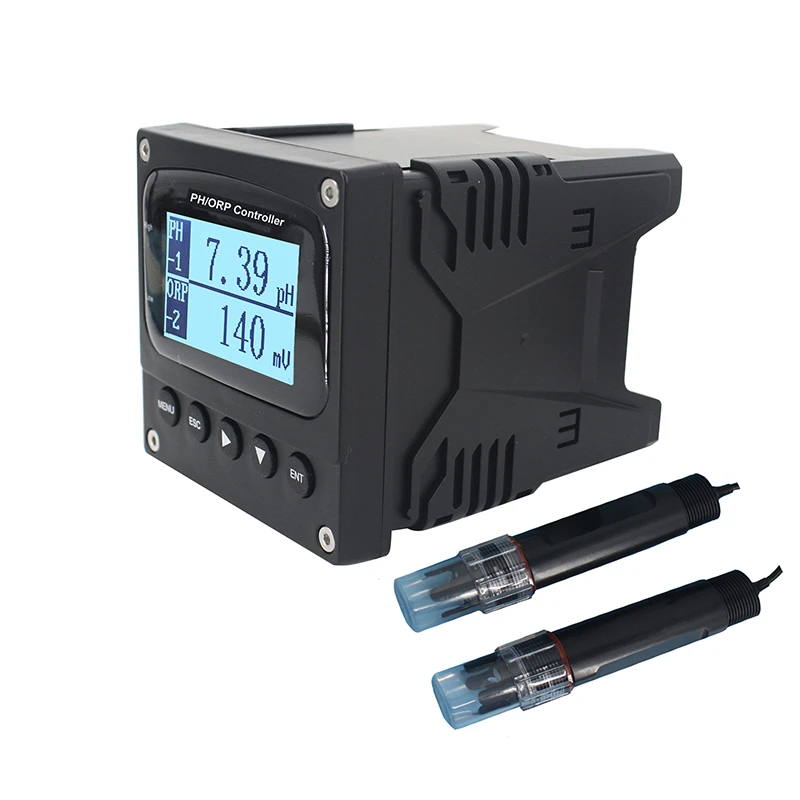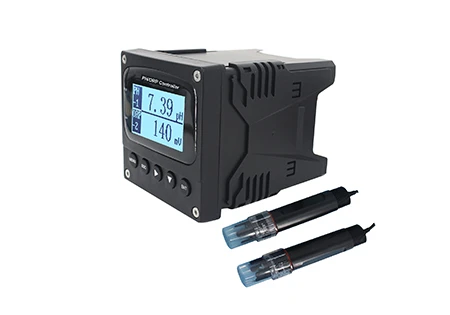PH ORP controller is an important instrument for water quality monitoring and regulation, and is widely used in swimming pools, water treatment, industrial processes, and agricultural irrigation systems. This device automatically adjusts the dosing equipment by monitoring the pH value and oxidation-reduction potential (ORP) of the water in real time to ensure that the water quality is within the optimal range. The PH value is used to measure the acidity and alkalinity of water, and the ORP value reflects the activity of the redox reaction in the water. The stable control of these two parameters is crucial to the safety of water quality and treatment efficiency.
The equipment is usually equipped with high-precision sensors that can detect the pH and ORP values of water in real time, and through the built-in control system, automatically start relevant dosing equipment (such as acid, alkali, oxidants, etc.) for adjustment, thereby maintaining stable water quality. Many PH ORP controllers also support data logging and remote monitoring functions. Users can view real-time data through a digital interface to facilitate remote management and fault diagnosis.
The use of this type of controller not only improves the efficiency of water treatment, but also significantly reduces the waste of chemicals and saves operating costs. The operating interface of the device is usually simple and easy to understand, and even users without professional knowledge can easily get started. With the continuous advancement of technology, modern PH ORP controllers are more intelligent and equipped with multiple alarm functions. When abnormal conditions are detected, they will automatically alarm and remind users to take action in time, thus effectively avoiding the occurrence of water quality problems. By using this kind of controller, water quality management is more scientific and accurate, and the automation level of water treatment is also greatly improved.

PH/ORP-6850

PC-6850
What Is A Ph Controller?
A pH controller is a device used to monitor and regulate the pH level of a liquid or water system, ensuring that it remains within a desired range for optimal performance. It is commonly used in various industries, including water treatment, swimming pools, aquariums, agriculture, and chemical processing. The pH level is crucial as it affects the chemical balance and biological processes of the water, influencing factors like plant growth, water quality, and the effectiveness of treatment chemicals.
The pH controller typically consists of a high-precision pH sensor, which continuously measures the acidity or alkalinity of the water. This sensor sends real-time data to the control unit, which compares the pH reading to pre-set parameters. If the pH level deviates from the target range, the controller automatically activates a dosing pump to add either an acid or alkaline substance to adjust the pH accordingly. This ensures that the system remains within the ideal pH range, minimizing manual intervention and improving efficiency.
Some advanced pH controllers also offer additional features such as data logging, remote monitoring, and alarm systems, alerting users to any issues in real time. This automation reduces the need for constant monitoring and chemical adjustments, saving time and chemicals. The pH controller is designed to be user-friendly, with easy-to-read displays and simple calibration processes, making it suitable for both professionals and non-experts. By maintaining optimal pH levels, the controller helps extend the lifespan of equipment, improves water quality, and enhances the overall performance of the system, making it a valuable tool for maintaining chemical balance and efficiency in various applications.
What Is The Purpose Of Ph Control?
The purpose of pH control is to maintain the optimal acidity or alkalinity levels of a solution, ensuring that it stays within a specified range for desired chemical, biological, or industrial processes. In many systems, the pH level directly influences the efficiency and effectiveness of chemical reactions, biological functions, and overall system performance. pH control is crucial in industries such as water treatment, agriculture, pharmaceuticals, food and beverage production, and chemical manufacturing.In water treatment, for example, pH control ensures that the water remains suitable for consumption, swimming, or industrial processes by preventing scale formation, corrosion, or harmful bacterial growth. In agricultural applications, controlling the pH of irrigation water or nutrient solutions helps optimize plant growth, as different plants have specific pH requirements for nutrient absorption. In chemical processes, maintaining a stable pH is essential for controlling the rates of reactions, product consistency, and the safety of operations.
pH control is achieved through the use of pH sensors, controllers, and dosing systems that monitor real-time pH levels and automatically add acids or bases to adjust the pH when necessary. By maintaining the correct pH, operators can ensure optimal performance, reduce the need for manual intervention, and minimize chemical waste. Proper pH regulation also prevents equipment damage, prolongs the lifespan of machinery, and ensures compliance with regulatory standards in various industries.PH control serves as a vital tool to maintain system stability, improve efficiency, safeguard equipment, and ensure the safety and quality of products or processes in diverse applications. It is an essential part of many automated systems, reducing human error and promoting consistent results.







